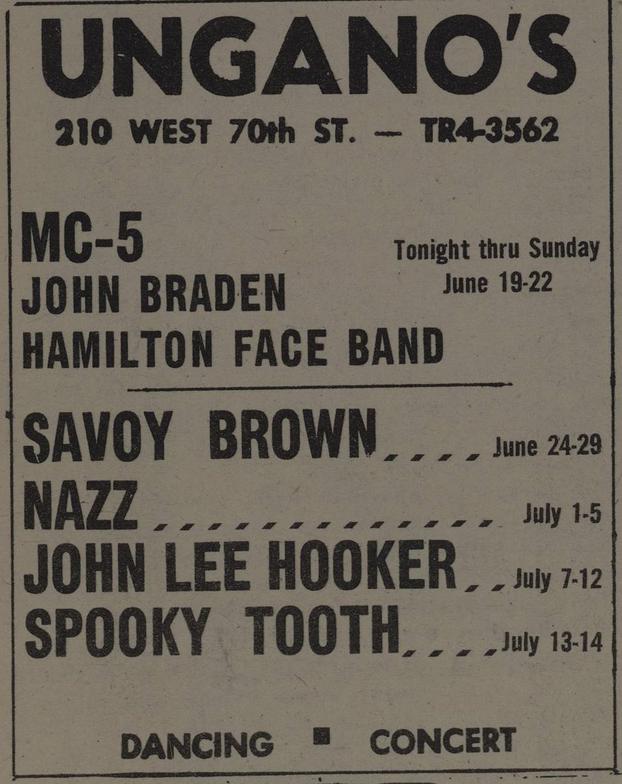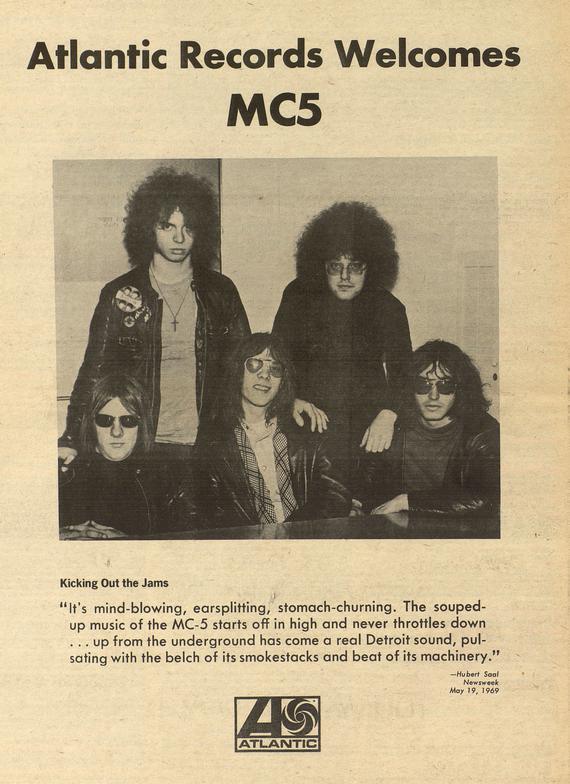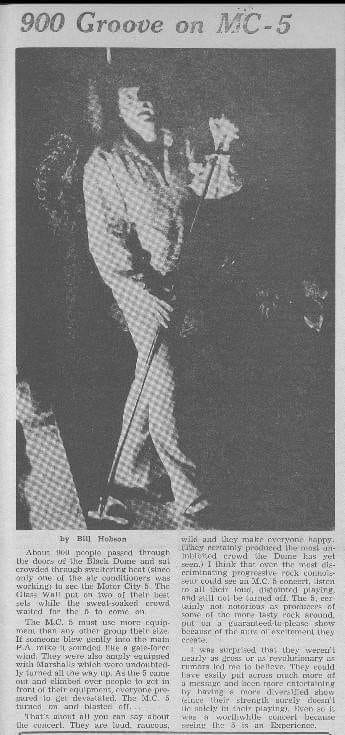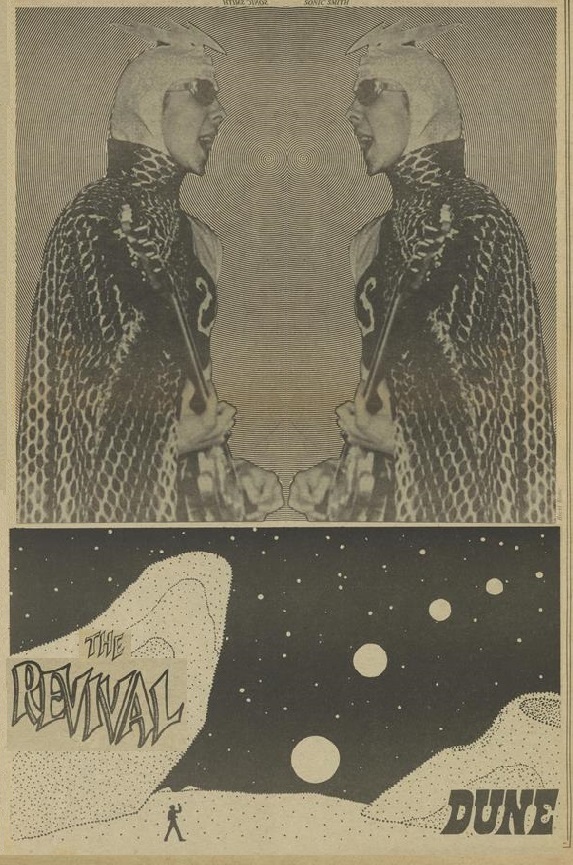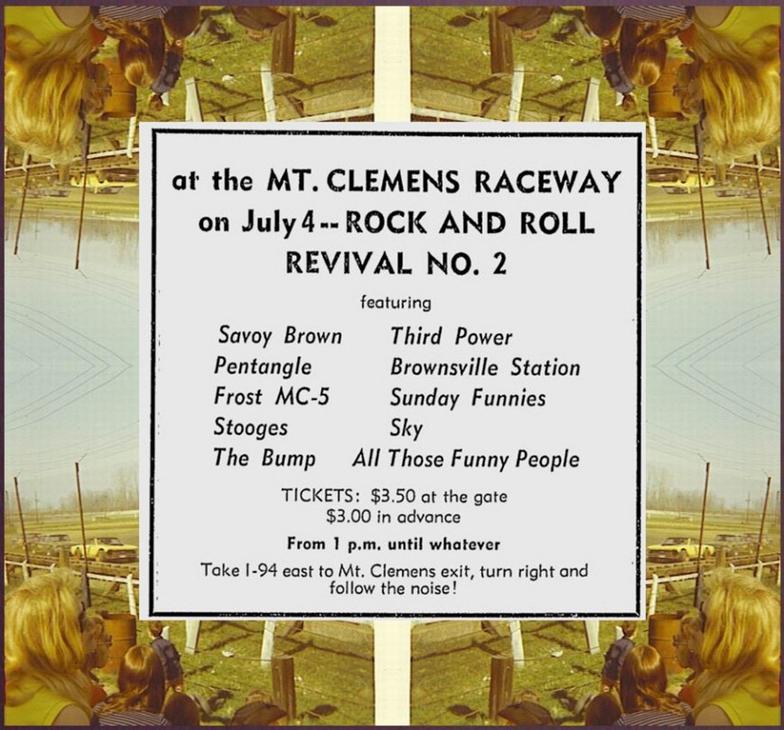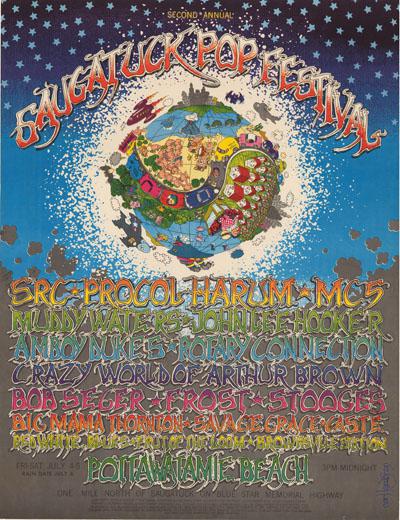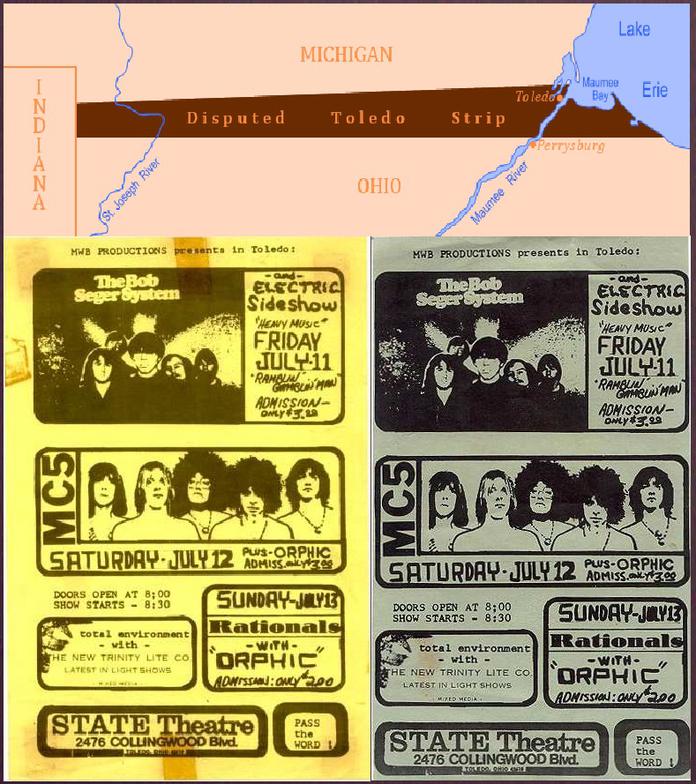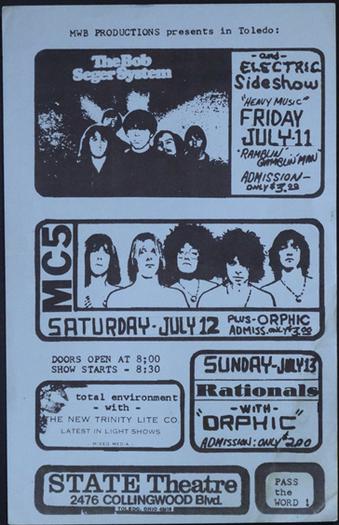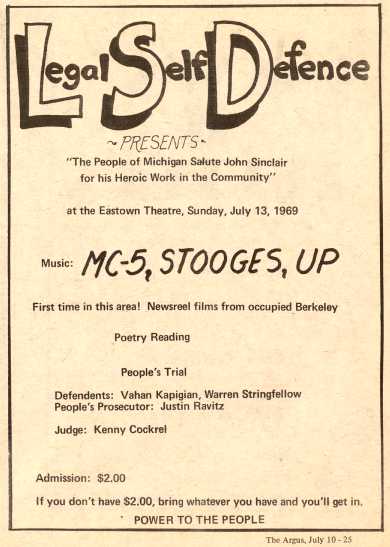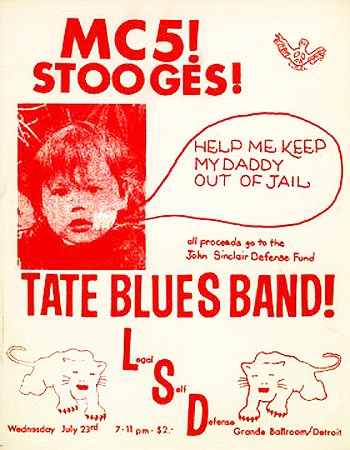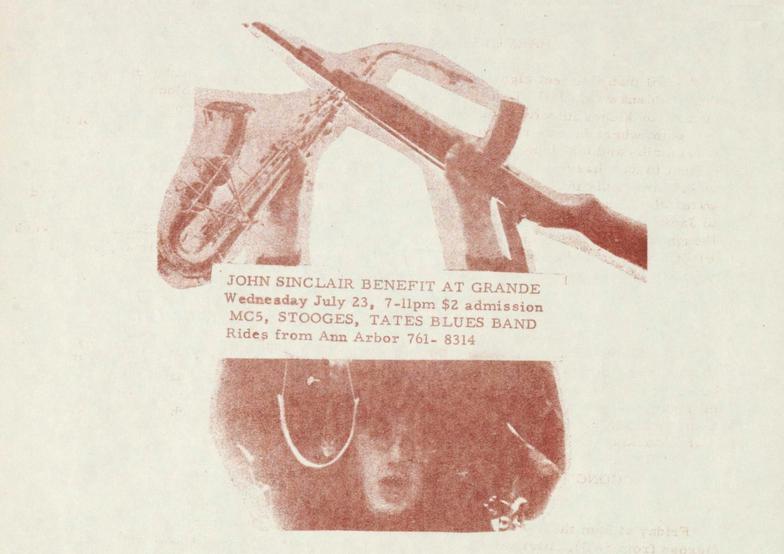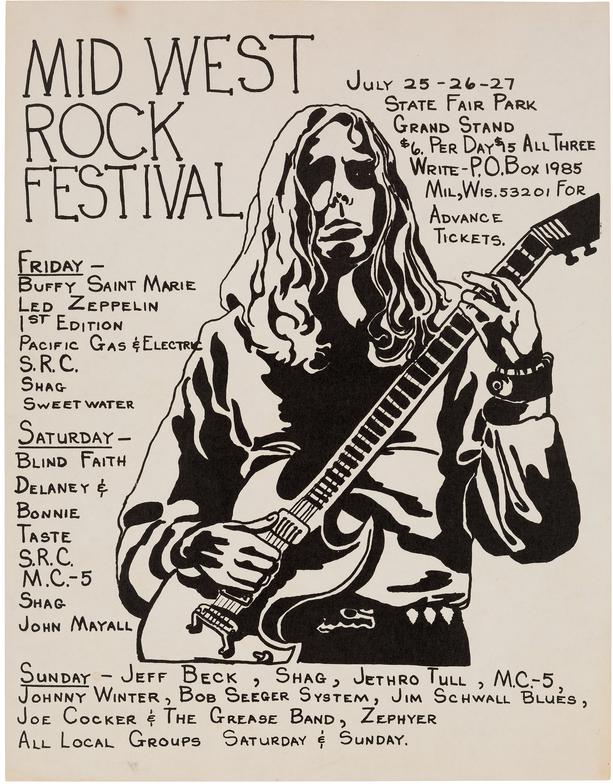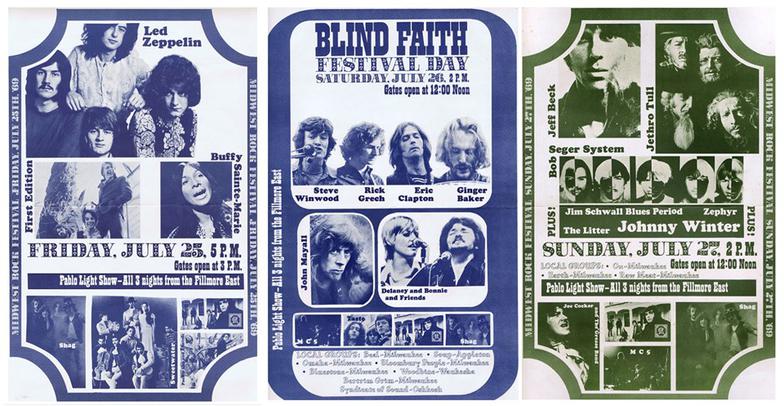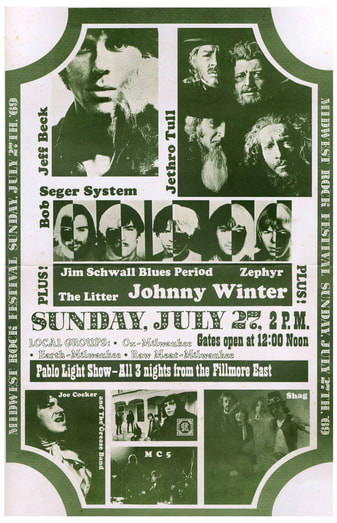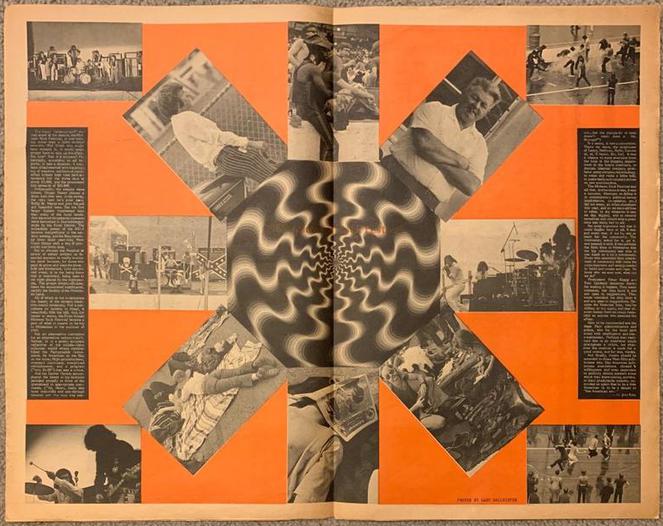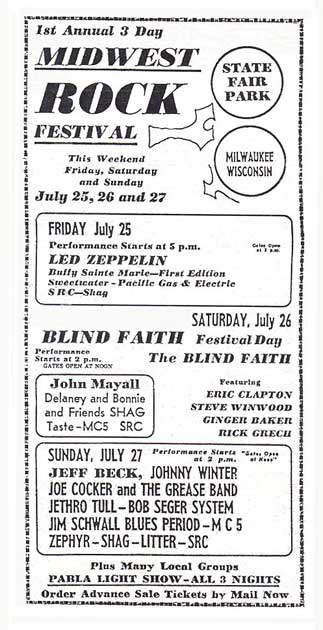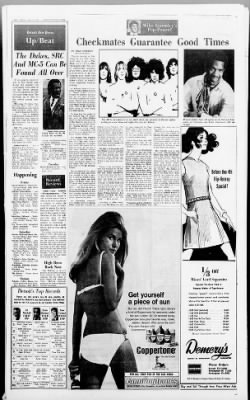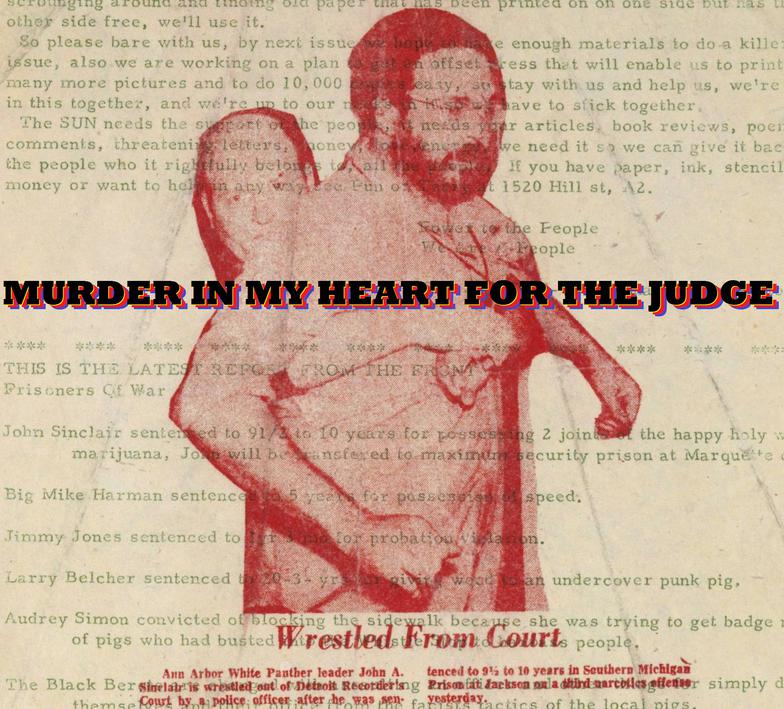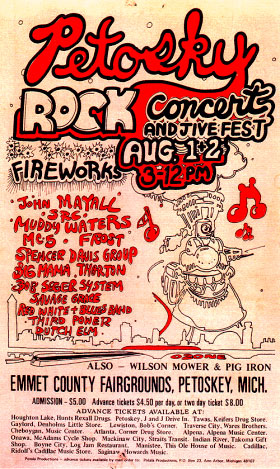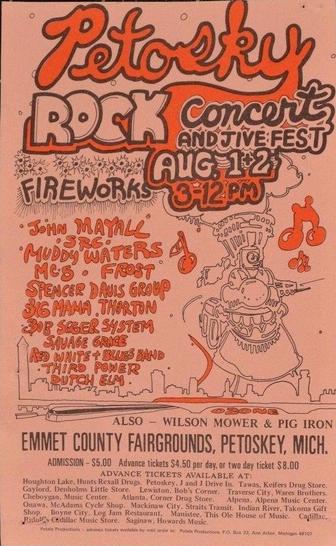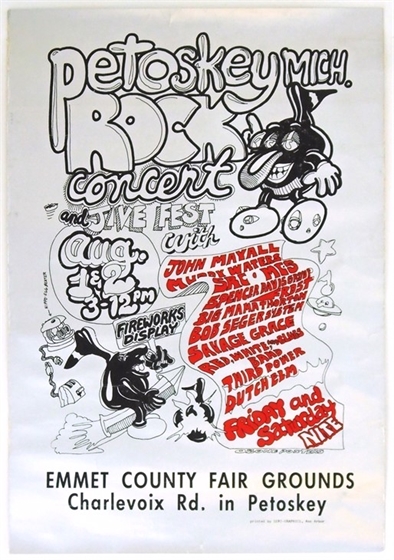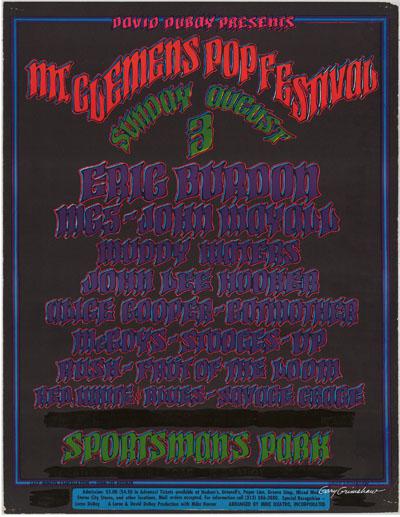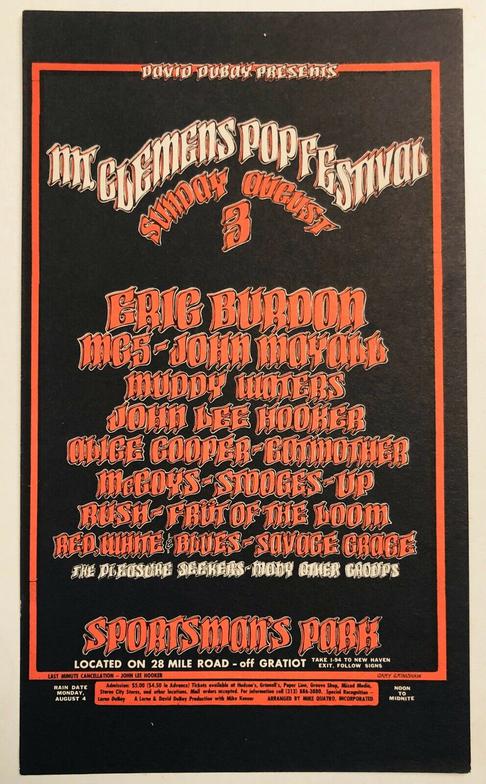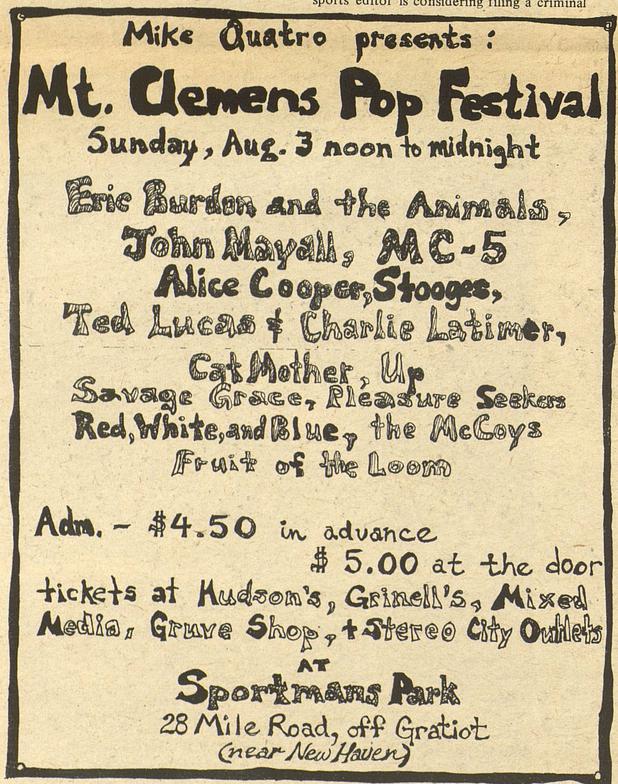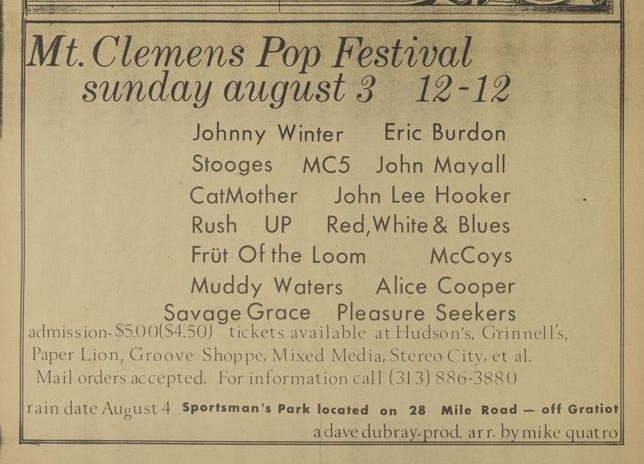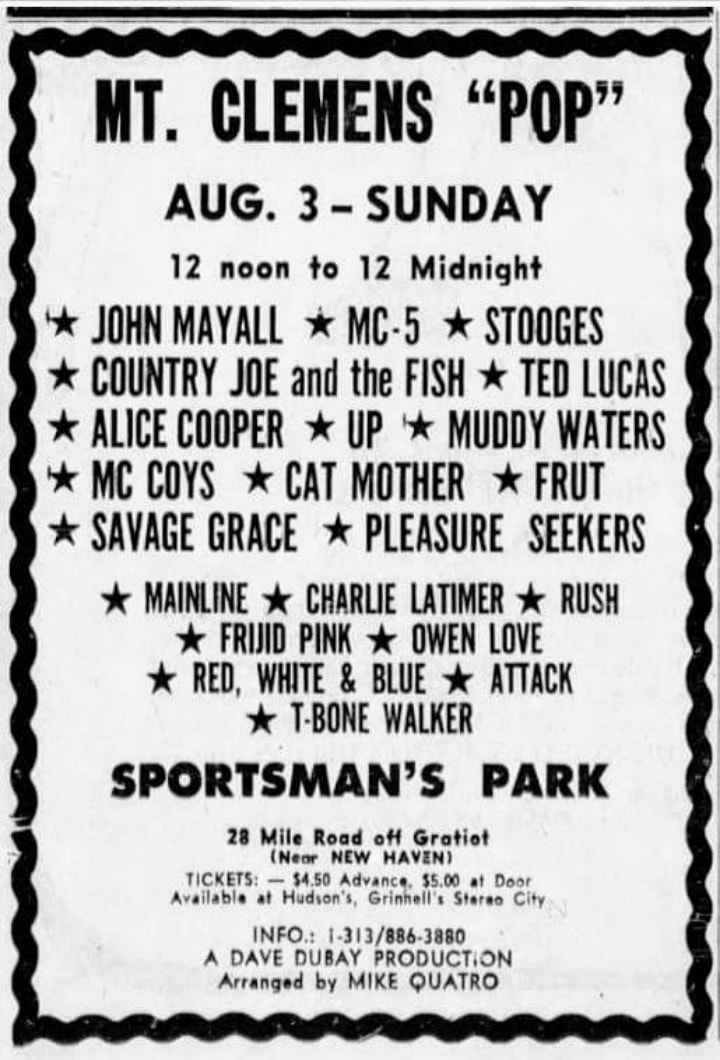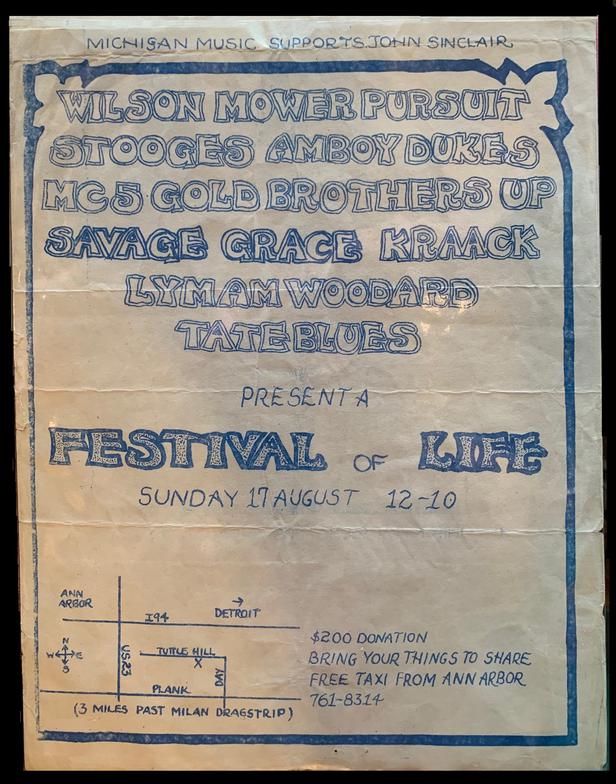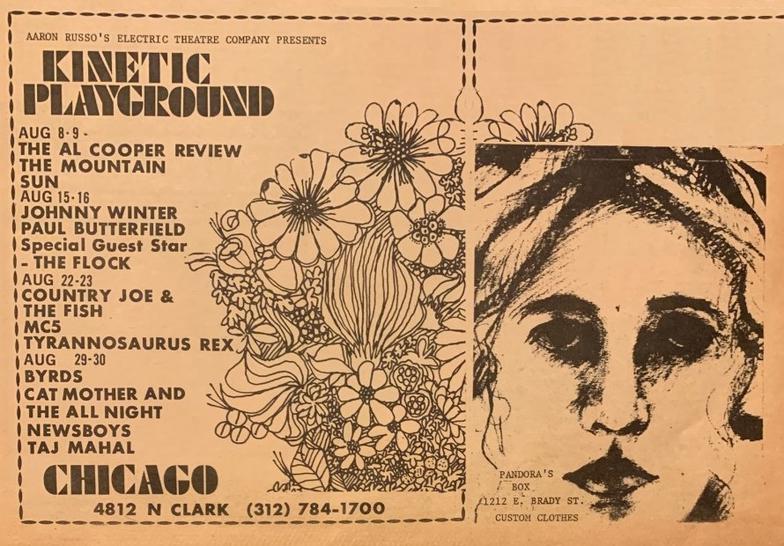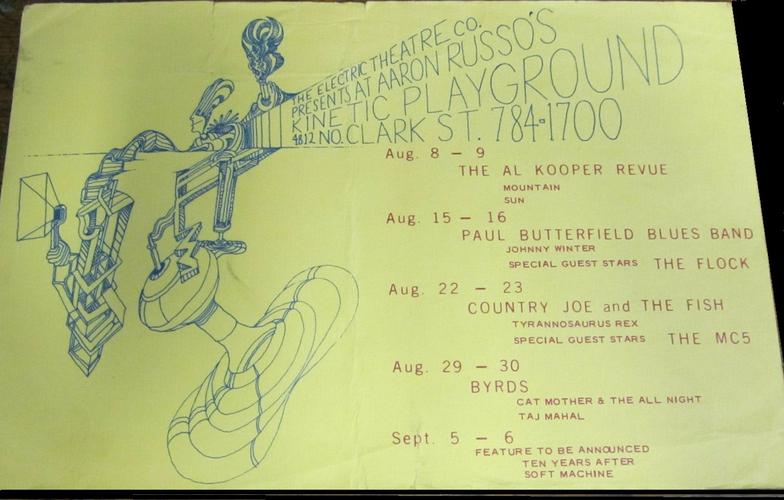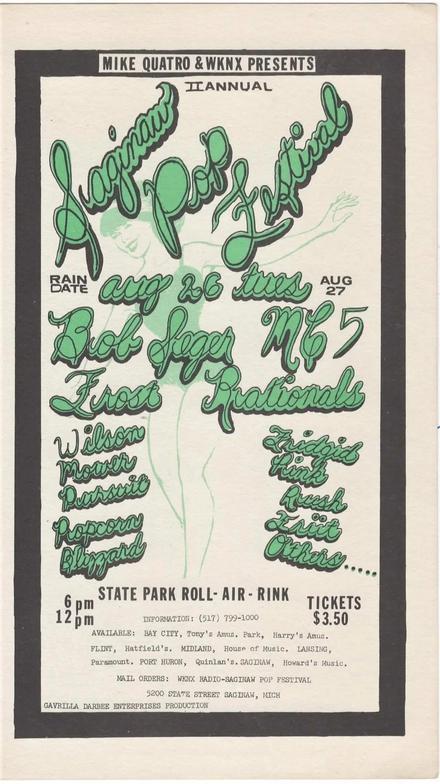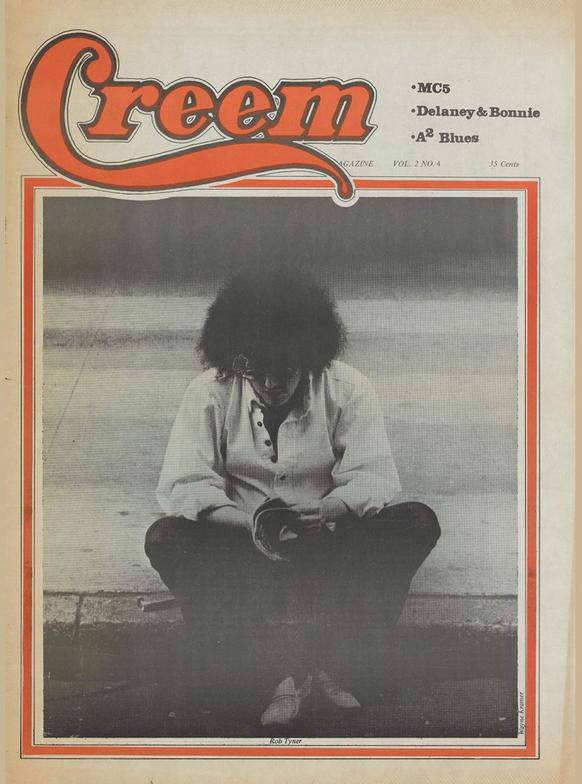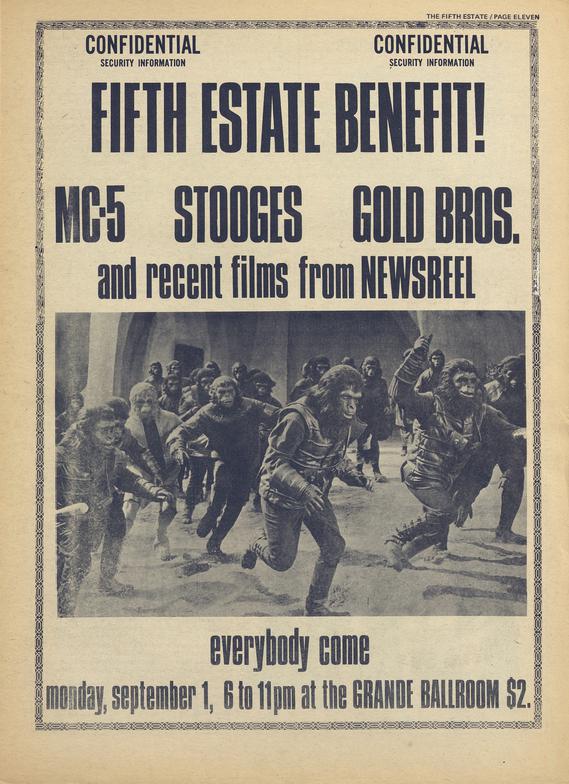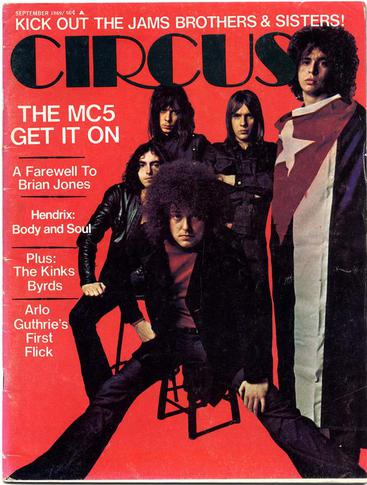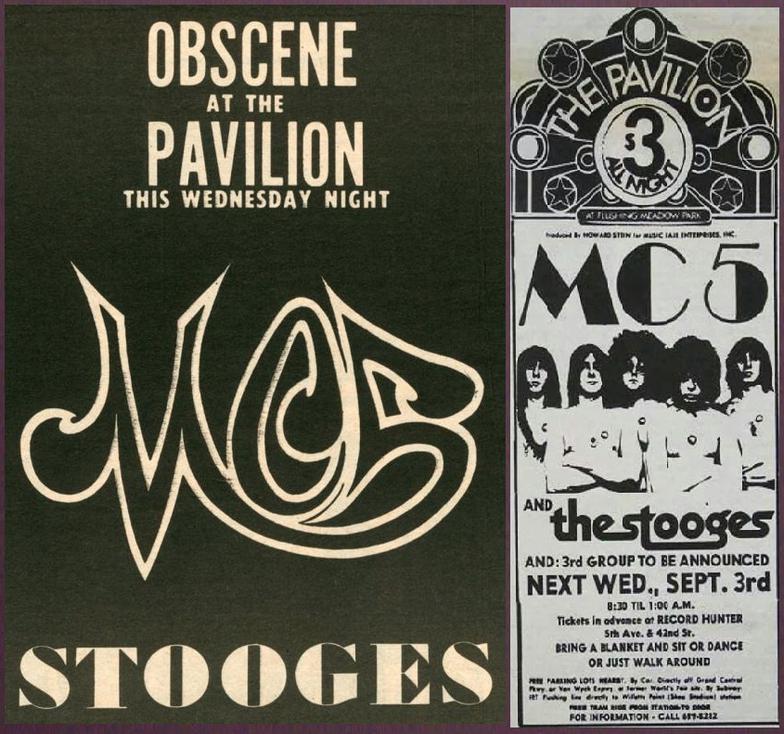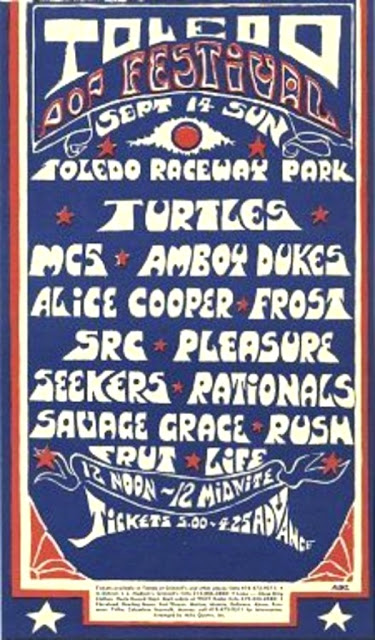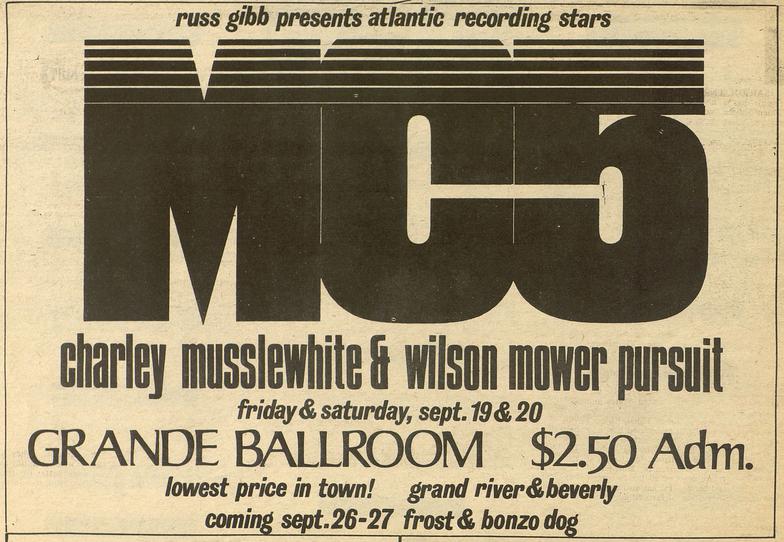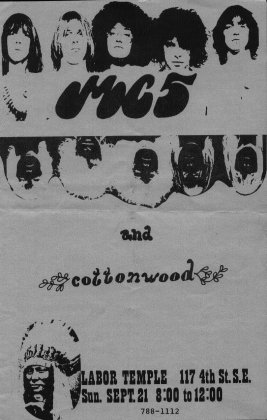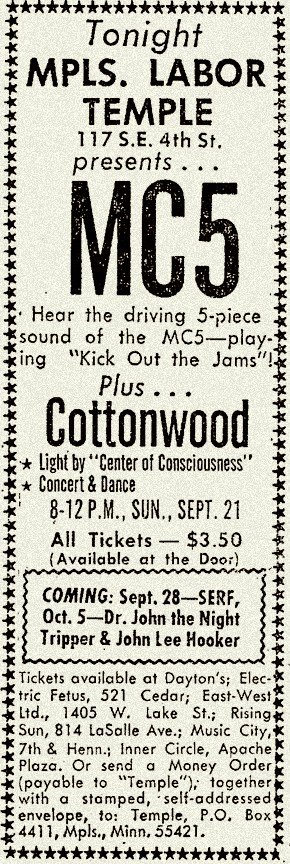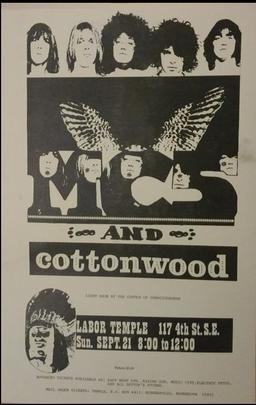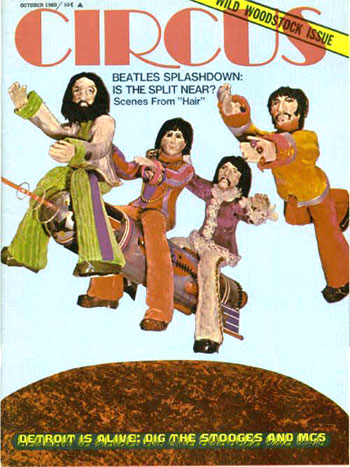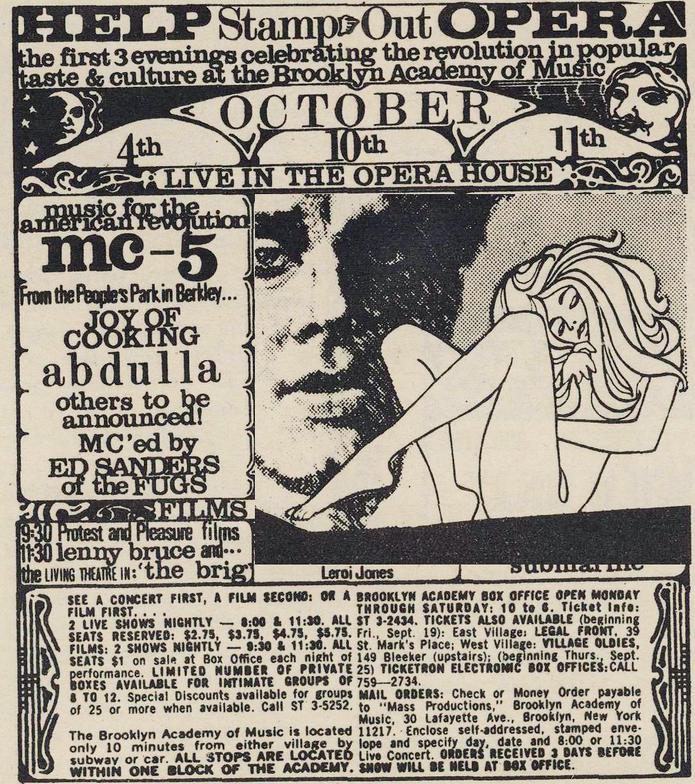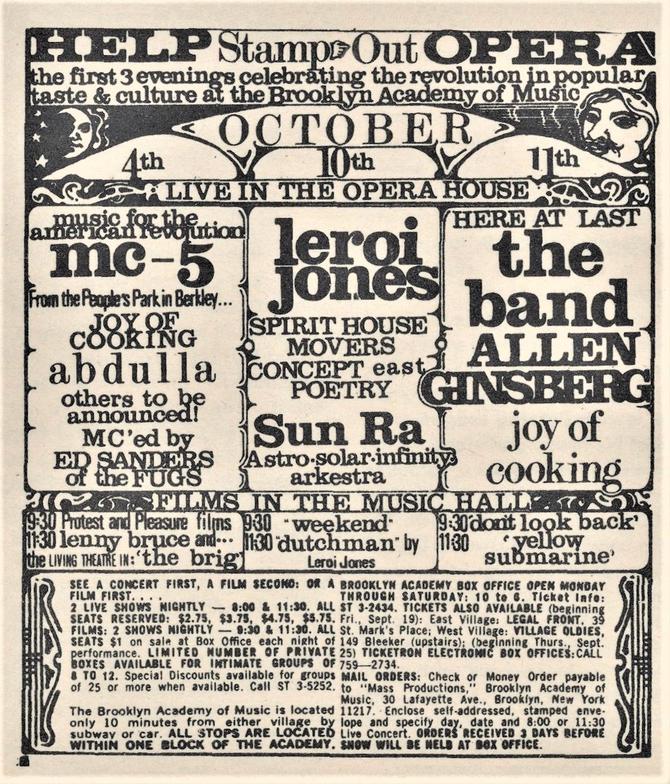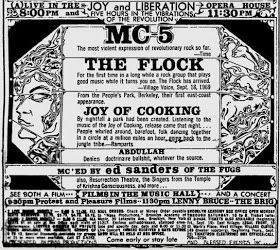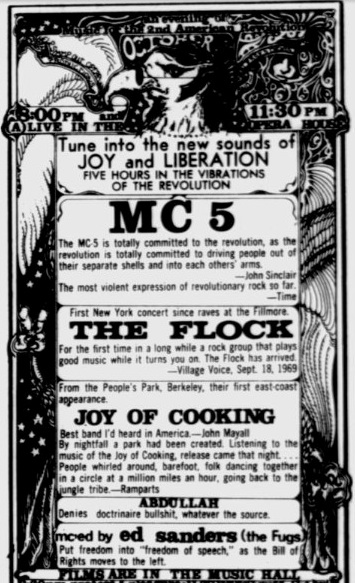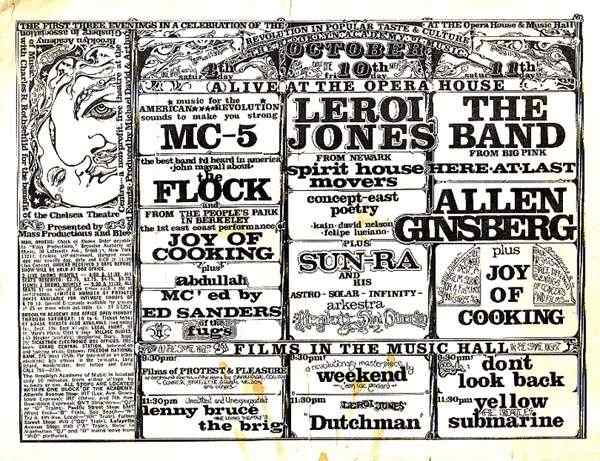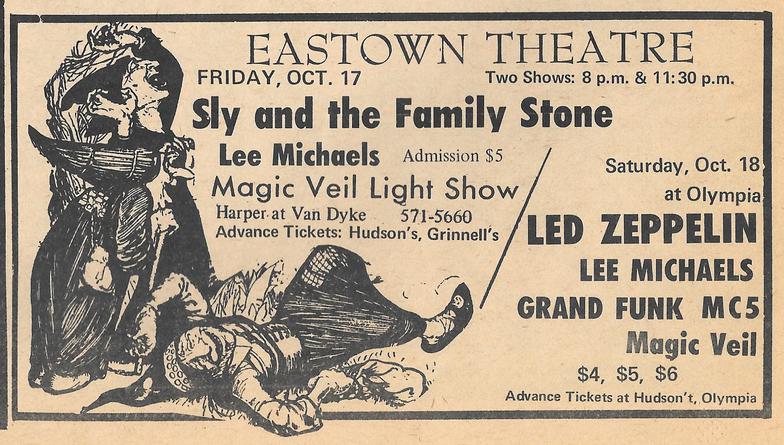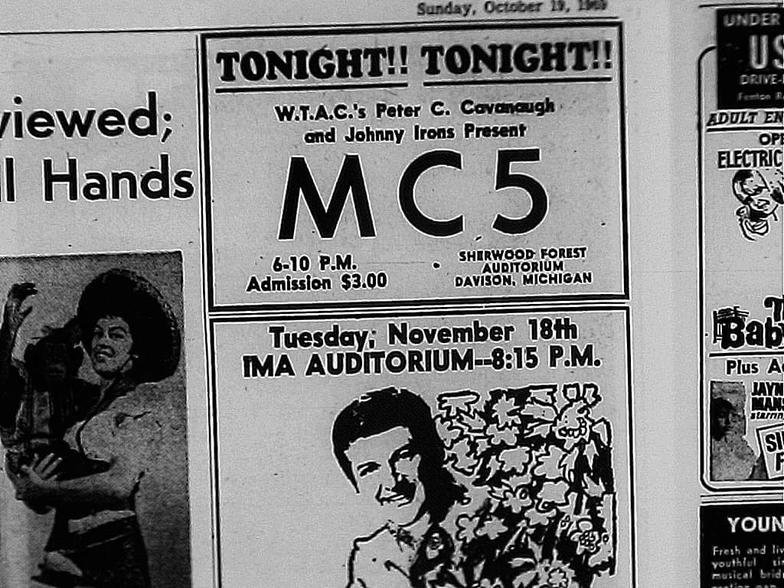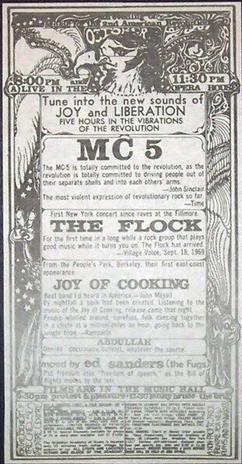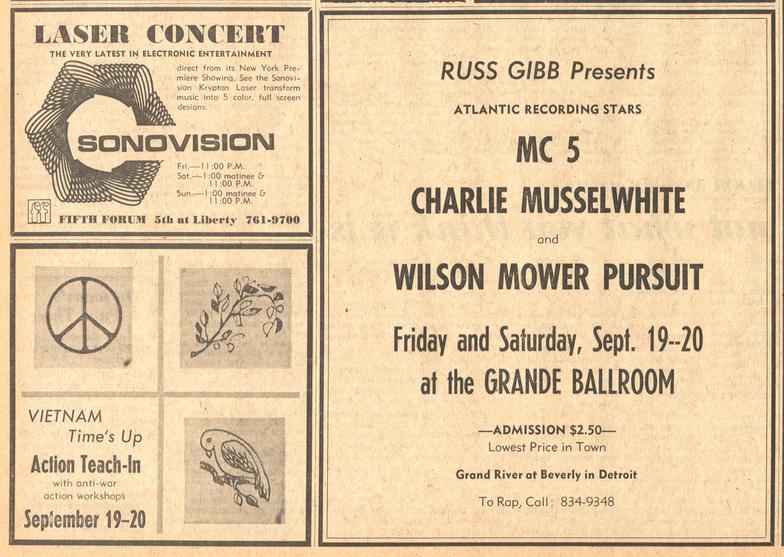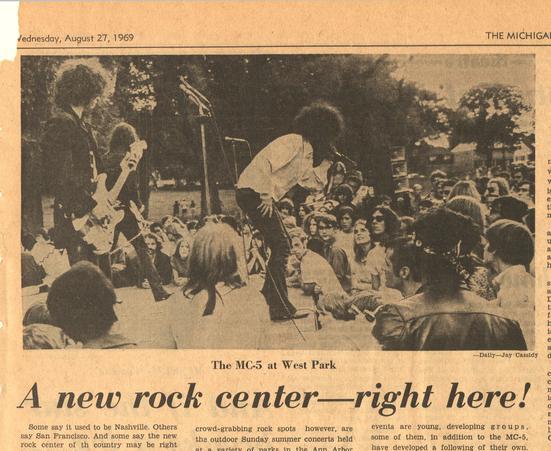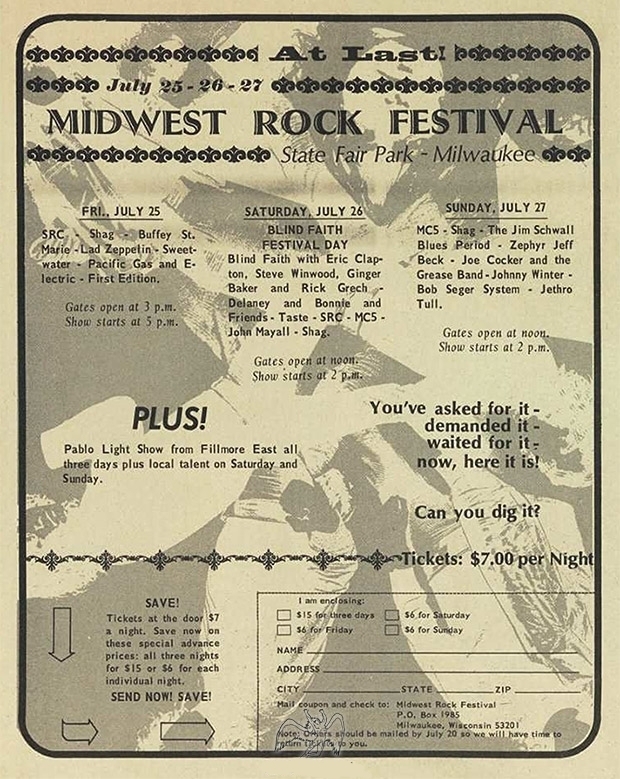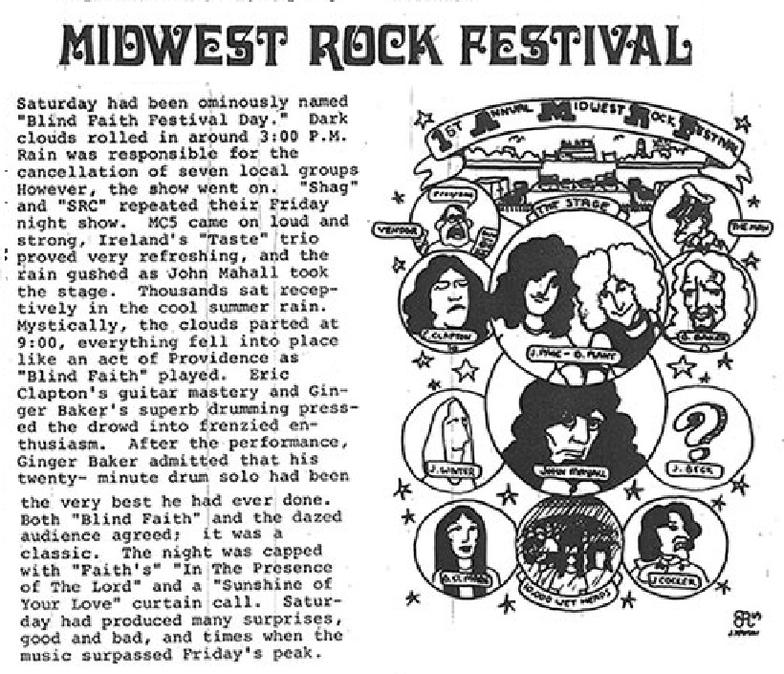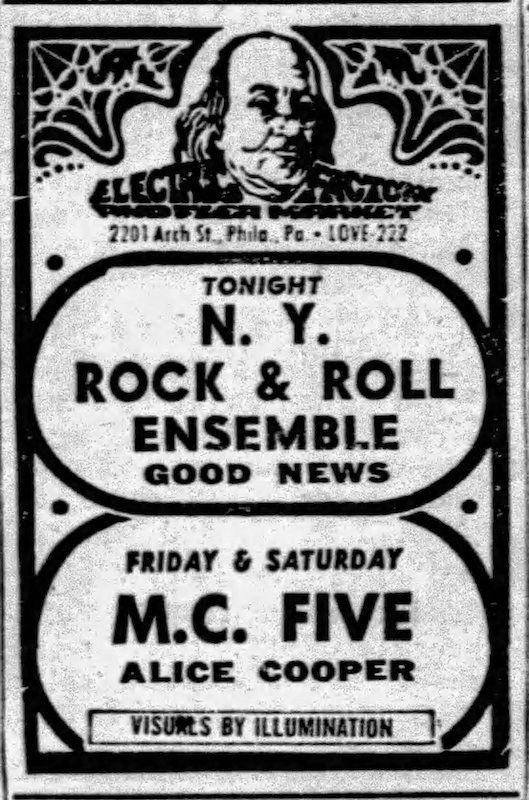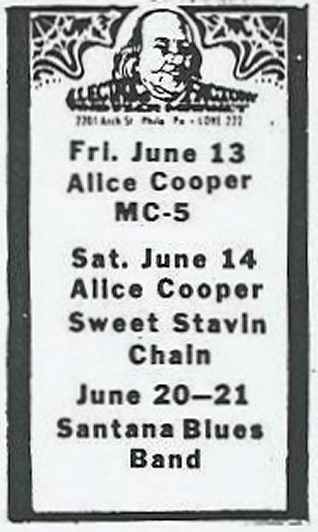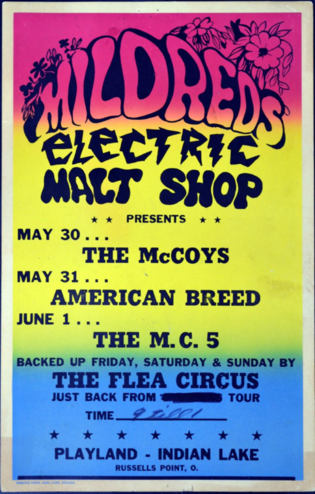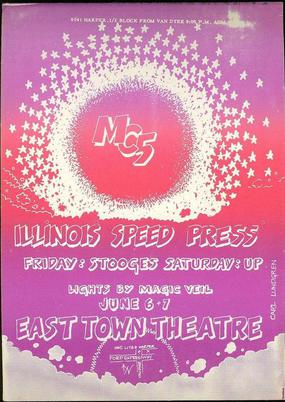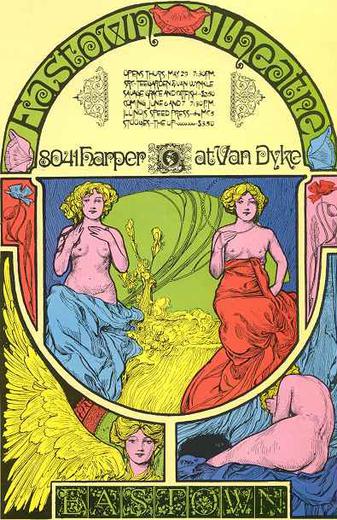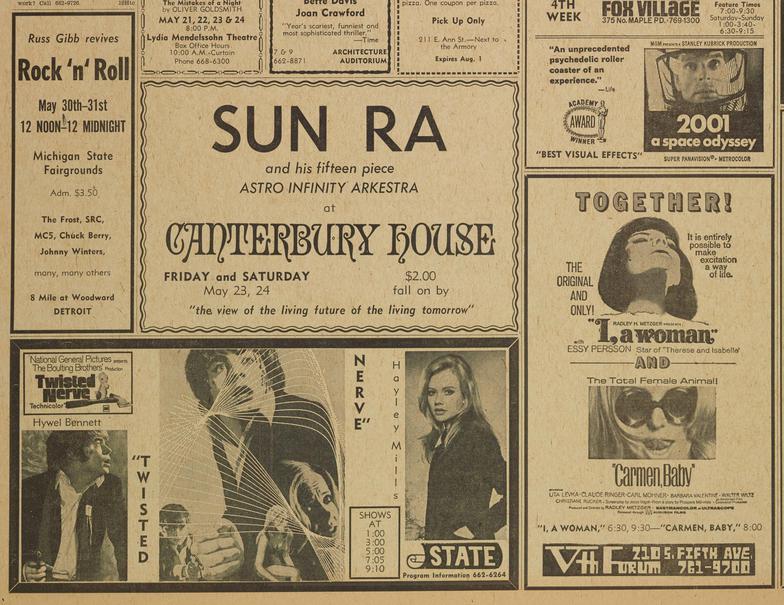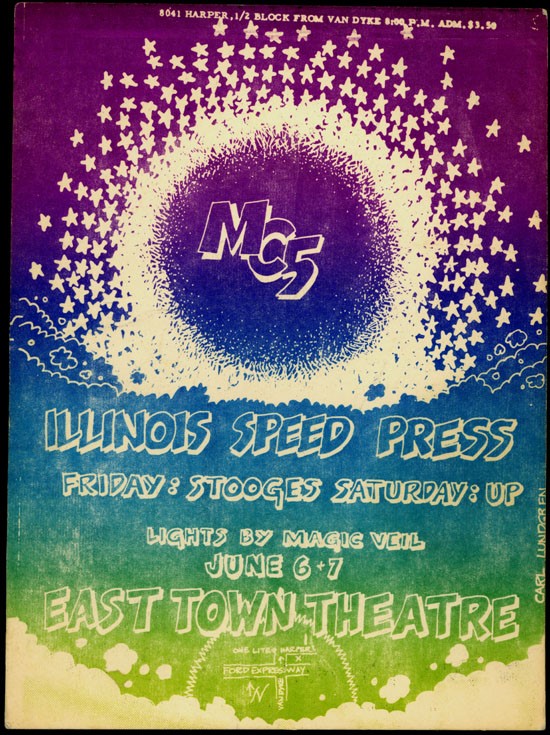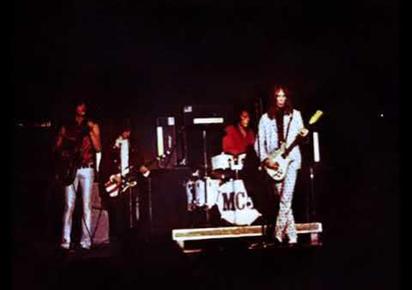Splatt Gallery
Double click here to add text.
Splatt Gallery's History of Michigan Music Posters
MC5 - Page Eight
***********************************************************
The MC5 used the advance from signing to Atlantic Records to move out of the Hill Street houses in Ann Arbor to their own farm in Hamburg, Michigan, and to launch another short tour of the East Coast. While in Boston, June 16-18, 1969, for this run of shows at The Ark, they hooked up again with Danny Field’s friend Jon Landau, and agreed to have Landau come to Michigan to produce their second album. Poster by Emmanuel.
An ad for Ungano’s in NYC with the MC5 on top for four nights, June 19-22, 1969.
A full-page ad in the June 19, 1969 edition of the Ann Arbor Argus newspaper in Ann Arbor, Michigan, announcing the signing of the MC5 to Atlantic Records.
A grainy photo and nearly impossible to read newspaper article that confirms a show by the MC5 at the Black Dome in Cincinnati, Ohio on June 28, 1969, a show that is missing from the Database and the Gateway timeline. On the other hand, those sources have the following June 1959 shows that we cannot confirm:
23 Monday / MC-5, Hamilton Face Band The Scene NYC
24 Tuesday / MC-5 The Note, Paw Paw, MI
27 Friday / MC-5 The Cobra Club, Hastings, MI
Photo of Fred Sonic Smith by Brett Rose in a review of the Detroit Rock & Roll Revival and an illustration by an unknown artist that accompanied a book review of Frank Herbert’s “Dune” in the July 1969 issue of CREEM magazine.
The seventh festival of the year was called the Rock and Roll Revival No. 2, held at the Mt. Clemons Raceway on the Fourth of July, 1969. The band All The Lonely People was listed as All Those Funny People.
Also on the Fourth of July, the eighth rock festival of 1969, the Saugatuck Pop Festival occurred simultaneously with the Rock and Rock Revival No. 2 in Mt. Clemens. Four of the bands, MC5, SRC, Stooges, and Brownsville Station played at both. Carl Lundgren created the poster.
You recall the town of Saugatuck, Michigan from our story of the Jazz Riots of 1961 that ended the annual jazz festivals, and from the first Saugatuck Pop Festival in 1968. Although the rock kids of 1968-1969 were not as riotous as the jazz kids of 1961, there were still plenty of reports of illegal and immoral activity, and just the sheer volume of attendance, estimated at 30,000 people, completely overwhelmed and shut down the town, so following the 1969 festival, the town filed an injunction against any more future festivals.
Detroit is closer to Toledo, Ohio, eighty miles to the south, than it is to the state capitol in Lansing, and until the Michigan-Ohio War of 1835, it was considered (by Michigan) to be part of Michigan. The dispute over the strip of land which included the commercially lucrative Maumee Harbor, went back thirty years to when Ohio had become a state and had established its borders in its state constitution based on a geographical error on a 1797 map. As Michigan sought statehood, it wanted its southern border to remain as established by the original Federal map of the Northwest Territory, and the war originated as a decade-long series of competing legislation, lawsuits, and appeals to the U.S. Congress.
In the summer of 1835, the conflict reached a head when two well-regulated militias, Michigan’s and Ohio’s, came face to face inside the disputed strip, although they mostly only threw taunts, insults and jeers at each other. Allegedly, shots were fired by the Michigan militia, allegedly in the air, as they chased some Ohioans off the land in what became known as “the battle of Phillips Corners”. The conflict’s only bloodshed occurred during the arrest of Ohio militia Major Benjamin Stickney and his three grown sons, One, Two, and Three when Two Stickney stabbed a the Michigan Sheriff in the leg.
The incident did prompt President Andrew Jackson to take action to avoid further escalation, and the end result was that Michigan would be granted statehood, give up the disputed strip to Ohio, and in compensation was given the entire Upper Peninsula.
One hundred and twenty years later, some animosity over Toledo persisted, although the sting of the economic loss of Toledo had been more than replaced by the discovery of copper and iron in the U.P., and the most popular band in Detroit was Toledo’s Johnny & the Hurricanes.
In late 1968, as previously documented, the Toledo band Kraack came to the attention of the Trans-Love Energies group, and there appears to have been a show by the Stooges at the Toledo Sports Arena on December 28, 1968, but in 1969, the floodgates seemed to have opened for Michigan bands playing in Toledo. This poster for the Toledo State Theater shows visits by Bob Seger, MC5, and the Rationals over a weekend in July, 11-13,1969. MC5 performed on the middle day, July 12, 1969.
Blue version of the poster for Bob Seger, MC5, and the Rationals over a weekend at the State Theatre in Toledo, Ohio, July, 11-13,1969.
Following the Bastille Day party and pig roast on the Sunday afternoon of July 13, 1969, there was a benefit that night at the Eastown Theatre to support John Sinclair’s legal battles, featuring MC5, Stooges, and UP.
The MC5 had physically separated themselves from John Sinclair and the White Panther Party when they moved out to Hamburg, Michigan with the advance they got from Atlantic Records to record their second album. Now they wanted to formally sever their ties with Sinclair as their manager and they had Sinclair come out to Hamburg for a meeting. They were appreciative of everything Sinclair had done for them, and they made a fairly generous offer to continue to send him 15% of their earnings, but they felt he couldn’t do much more for them. They also informed him that they would no longer desire the services of Brother JC Crawford, the Zenta high priest, in opening their shows with his audience exhortations.
At one point in the conversation, someone allegedly pointed out that Sinclair could possibly be in jail in the near future, but nobody really believed that. The benefit shows continued to raise money, such as this show at the Grande Ballroom, July 23, 1969, (ten days after a similar event at the Eastown) with MC5, Stooges, and Tate Blues Band, victories were being achieved by his legal team over the two-and-a-half-year long battle, and nobody thought that Sinclair would ever go to jail. Poster by an unknown artist.
An ad in the mimeographed SUN newsletter for the John Sinclair Benefit at the Grande Ballroom on July 23, 1969, with MC5, Stooges, and Tate Blues Band.
1969 was the second year for a rock festival in Milwaukee, Wisconsin, the previous Milwaukee Pop Festival of 1968 was one of multiple events at various locations around the city, loosely grouped together under the name Summerfest.
The festival had originated the year before, inspired by the mayor’s visit to Oktoberfest in Munich, Germany, and the 1967 event was called Juli Spass, German for “July Fun”, the less-ethnically-tinged Summerfest title was adopted before the follow-up in 1968.
The 1969 Summerfest again followed the format of scattered, separate events around the city, including this Midwest Rock Festival which was held at the State Fair Park, the stage was a flatbed trailer. Cold and rainy weather contributed to low attendance at all the events and the following year, the 1970 Summerfest, all events were consolidated to a single location, a former NIKE missile base on the shores of Lake Michigan, where it remains to this day.
Summerfest has since evolved into the largest music festival in the Western hemisphere, drawing about a million people over its week-long run. That is topped by the Mawazine Festival in Morocco, another week-long festival that draws two million.
But the largest music festival in the world, Donauindelfest brings an incredible three million people to an island in the Danube River in Austria over just a three-day (free) program.
The 1969 Midwest Rock Festival, July 25-27, 1969, included Michigan bands, SRC, MC5, and Bob Seger, (who may have been rained-out). MC5 performed on both Saturday and Sunday, July 26-27, 1969.
A nice set of handbills for the Midwest Rock Festival in Milwaukee, Wisconsin, July 25-27, 1969, with the Bob Seger System, SRC, and MC5 on the final day. Jeff Beck and Jethro Tull may have cancelled. MC5 also performed on the middle day, and SRC performed on all three days.
Poster for the last day of the three-day Midwest Rock Festival in Milwaukee, Wisconsin, July 27, 1969, with photos of the Bob Seger System, MC5, and SRC. Also, the full festival line-up flyer.
A two-page spread in the Madison Kaleidoscope newspaper recapping the Midwest Rock Festival in Milwaukee, Wisconsin, July 25-27, 1969. The MC5 are in the center photo on the left (with Confederate and Skull & Bones banners), and SRC are in the center photo on the right.
The July 27, 1969 edition of the Detroit Free Press with an article pointing out that local bands Amboy Dukes, SRC, and MC5 “can be found all over”, and a classic Sixties Coppertone ad.
The White Panthers never thought it would happen, so the speed and finality of Judge Robert Columbo’s sentencing came as a complete shock. On July 28, 1969, John Sinclair was sentenced to 9-1/2 to ten years in prison for the possession of two joints in the December 1966 sting operation. No further delays or appeals, no more bail bonds, he was immediately hauled away, out of the courtroom, and put behind bars.
Moby Grape – Murder in my Heart for the Judge (1968)
https://www.youtube.com/watch?v=2xEbbyKJ0mk
The ninth Michigan festival of 1969 happened in Petoskey, near the top of the Lower Peninsula of the state, about 300 miles northwest of Detroit on August 1-2, 1969. The Detroit bands were well-represented, with classic blues artists as the headliners. MC5 Performed on August 1, 1969, possibly both days(?)
Poster is by Ozone, the name used by artist Chris Frayne, the brother of Commander Cody.
A second version of the poster for the Petosky Rock Festival, August 1-2, 1969. Like the first poster, this one was also made by Chris Frayne.
Another summer weekend in Michigan in 1969, and yet another Pop Festival, this time at Sportsman’s Park in Mt. Clemens on August 3, 1969, the tenth major festival of the year, so far.
The main headliner, Country Joe & the Fish, are missing from this Gary Grimshaw poster. The band Rush is a Warren, Michigan band and not the group that was just in the process of forming in a Toronto, Canada suburb.
Grimshaw’s poster is also missing a number of other acts that are said to have performed, The Attack, Ted Lucas, Owen Love, and The Pleasure Seekers, whom we haven’t seen since their mismatched spring touring with The MC5.
And the band from Union City, Indiana, The McCoys had weathered their early teen band success from their 1966 hit “Hang On Sloopy”, after a few years of endless re-makes of that pop song, they recorded a couple of albums of psychedelic blues-rock. This would be their final Michigan appearance, in 1970 the band became Johnny Winter’s touring unit, while the McCoy’s guitar player, Rick Derringer, joined up with Winter’s brother, Edgar.
Newspaper ads for the Mt. Clemens Pop Festival on August 3, 1969. A Mike Quatro presentation featuring Eric Burdon & the Animals, John Mayall, MC5, Alice Cooper, Stooges, Ted Lucas & Charlie Latimer, Cat Mother, UP, Savage Grace, Pleasure Seekers, Red, White & Blues Band, the McCoys, and Fruit of the Loom.
More newspaper ads for the Mt. Clemens Pop Festival on August 3, 1969 that lists eight additional acts to the original line-up.
Members of the White Panther Party spent a week building a stage in a farm field in Milan, Michigan, in preparation for an August 17, 1969, “Michigan Music Supports John Sinclair Festival of Life” concert with The MC5, Stooges, Amboy Dukes, Gold Brothers, Up, Savage Grace, Tate Blues, Lyman Woodard, and our favorite Toledo, Ohio band, Kraack.
The concert was cancelled at the last minute when the Musicians Union informed the bands that if they performed for free they would be kicked out of the union. It rained that day, which would have ended the performances anyway, but a big wet party took place after which the Monroe County Sheriffs visited the farmer and told him they would never allow the rescheduling of the full event for any future date. And somehow, the stage was stolen.
Poster by an unknown artist.
Another show missing from both timelines, so perhaps it was cancelled, for the MC5, with Country Joe & the Fish and Tyrannosaurus Rex, at the Kinetic Playground in Chicago, August 22-23, 1969.
Poster/flyer for the Kinetic Playground in Chicago with the MC5 appearing with Country Joe & the Fish and Tyrannosaurus Rex on August 22-23, 1969.
The thirteenth Michigan music festival of 1969, on August 26, 1969, changed its name to the 1st Michigan Pop Festival after these posters by an unknown artist had already been made. One reason was that there had already been a Saginaw Pop Festival in April and to have the “Second Annual” merely four months later belied the definition of “annual”. Furthermore, it wasn’t even going to take place in Saginaw, but rather in Bay City at the Roll-Air skate park. There don’t appear to have been any posters made with the name 1st Michigan Pop Festival for this event.
A Mike Quatro presentation featuring Bob Seger, MC5, Frost, Rationals, Wilson Mower Pursuit, Frijid Pink, Popcorn Blizzard, Frut, Rush, “and others”.
The band Rush is not the future-famous Canadian band, nor is it the Warren, Michigan band of the same name that we saw earlier at the Mt. Clemons Pop Festival, but rather a second Michigan band named Rush, from Flint that included Mark Farner’s brother Ricky.
The MC5 apparently were a no-show for the festival while they worked on finishing up the recording for their second album.
A photo of Rob Tyner, which is credited to Wayne Kramer, on the front cover of the ninth issue of CREEM magazine, which is numbered as Vol 2, No. 4, published in September 1969. The events calendar had events that ran from August 29 through September 20.
Full-page poster ad by an unknown artist in the Fifth Estate newspaper in Detroit for their own benefit show at the Grande Ballroom, September 1, 1969 with MC5, Stooges, and Gold Bros.
The MC5 made the cover of the September 1969 issue of Circus magazine, the first Michigan artists to be on the cover, although this was only issue #7 of the publication.
Two additional posters for the September 3, 1969 show in Flushing, New York, although the previously posted Elektra Records ad was promoting the New York debut of the Stooges, the MC5 were the headliners.
The 17th Michigan music festival of 1969, yes, Toledo is in Ohio, but as you should recall from a previous post, it really belonged to Michigan, plus, look at the line-up with Michigan artists MC5, Amboy Dukes, Alice Cooper, Frost, SRC, Pleasure Seekers, Rationals, Savage Grace, and Frut.
Again, the band Rush is not the Canadian band, but likely one of the two Detroit bands named Rush that we’ve found before, although we seem to recall seeing something somewhere that suggested this is yet a third band named Rush, maybe from Ohio.
The Turtles were fresh off their two night stand at The Grande Ballroom and seem even more out of place here.
The poster for this September 14, 1969 show was made by CREEM magazine artist, Linz.
The 152nd weekend at the Grande Ballroom, September 19-20, 1969, and the return of the MC5 to the ballroom for the first time in four months (other than a July 23 benefit for Legal Self Defense, the last time had been opening for Sun Ra in May – which was also the last Grande Ballroom show with a decent poster). Charlie Musselwhite and Wilson Mower Pursuit also performed both nights.
Charley Musslewhite had performed at the Ann Arbor Blues Festival a month earlier and this appears to be his first Detroit appearance, which is odd considering how he was such good friends with John Lee Hooker. Hooker was the best man for Musslewhite’s third marriage, and Musslewhite convinced Hooker to move to California to join him after Musslewhite left Chicago and found admiration from the hippies in San Francisco.
In Minneapolis, Minnesota, the Labor Temple was their version of the Grande Ballroom, a dance hall that had been popular in the 1940’s and had fallen into un-use for a decade until promoter David Anthony started renting the upper floor for Sunday night psychedelic rock shows, the first one was the Grateful Dead on February 2, 1969.
The following link provides an excellent, complete show history of the Labor Temple, along with many great posters by their main poster artist Juryj (“George”) Ostroushko (brother of musician Peter), although, unfortunately, the above poster for The MC5 on September 21, 1969 is not one of his. The list also shows a cancelled MC5 show in October, 1970, and the very last, final show was Michigan bands Amboy Dukes and Alice Cooper on November 8, 1970.
http://twincitiesmusichighlights.net/venues/labor-temple/
Following the MC5’s cover on the September issue, the cover of the October 1969 issue of Circus magazine had the headline for the follow-up story “Detroit is Alive: Dig the Stooges and MC5”.
On October 4, 1969, the MC5 led off a three-day experimental program at the Opera House in Brooklyn, New York, that combined live music with film and poetry. Here are the first two of a series six of these elaborate ads.
The next two of the ads for the MC5 at the Opera House in Brooklyn, New York, October 4, 1969.
The last of the five ads for the MC5 at the Opera House in Brooklyn, New York, October 4, 1969.
A rare print ad for the Eastown Theatre in Detroit, Michigan, with Sly & the Family Stone and Lee Michaels appearing on October 17, 1969. The ad also notes the show by Led Zeppelin, Lee Michaels, Grand Funk and MC5 at the Olympia Stadium in Detroit for the following night, October 18, 1969.
Led Zeppelin returned to Detroit for their third visit of the year, October 18, 1969, by this time their popularity had outgrown the Grande Ballroom and Russ Gibb booked them at the Olympia Stadium. Ticket sales still were slow, so a week before the show two acts were added to the line-up, the MC5, who were now label mates with Zeppelin, both on Atlantic Records, and Grand Funk Railroad who had just been signed to legendary Frank Barsalona’s Premier Talent agency, who was also the agent for Led Zeppelin. The expanded bill worked and they sold capacity.
Having pulled off successful preliminary Wild Wednesday and Super Sunday shows at the Sherwood Forest outside of Flint, Michigan, WTAC DJ Peter C. Cavanaugh had the perfect choice in mind for the band to play the Grand Opening of the new larger dance hall that owner Don Sherwood had just finished constructing on the property, the band was The MC5.
The date for the grand opening was set for October 19, 1969 and Cavanaugh came up with a theme for promoting the show as “The End of the World”, creating a sixty-second radio spot and, in his words, “killer ‘End of the World’ posters and flyers printed and circulated at every record store, bar, shopping mall and theater complex in a fifty-mile wide area”.
How on earth have we never seen one?
Not the poster we hoped for, but here is an ad for the MC5 at Sherwood Forest from the day of the show, October 19, 1969.
Poster History of the MC5 - continues - HERE
A newspaper ad for the MC5 with Charley Musslewhite and Wilson Mower Pursuit at the Grande Ballroom on September 19-20, 1969.
An article in the August 27, 1969, issue of the Michigan Daily newspaper featured a photo of the MC5 at West Park by Jay Cassidy and provided a brief general summary of the current music scene in Ann Arbor.
A review of the Midwest Rock Festival in The Minneapolis Flag newspaper noted “MC5 came on loud and strong”.
A pair of ads for the MC5 with Alice Cooper at the Electric Factory, June 13-14, 1969, the second show of an East Coast tour that started with a performance at Tompkins Square Park in New York on June 11th.
The Gateway timeline has an odd show for the MC5 at a place called Mildred’s Electric Malt Shop in Russell’s Point, Ohio, with The Flea Circus on June 1, 1969, and here we’ve found a great Tribune Press poster for that show.
The second weekend at the Eastown Theatre, June 6-7, 1969 featured Carl Lundgren’s second poster for the venue, with MC5, Illinois Speed Press, Stooges, and UP.
An earlier poster by an unknown artist for the opening of the Eastown Theater in Detroit with a show list that includes the MC5, June 6-7, 1969.
Ads in the Michigan Daily newspaper in Ann Arbor with Sun Ra appearing at the Canterbury House, May 23-24, and an early ad for the Rock & Roll Revival, “Russ Gibb revives”, at the Michigan State Fairgrounds, May 30-31, 1969.
The MC5 performed at Westfield High School in Westfield, New Jersey on October 3, 1969. The concert was recorded and can be heard here:
https://www.youtube.com/watch?v=Xbg9OMJznJ4



